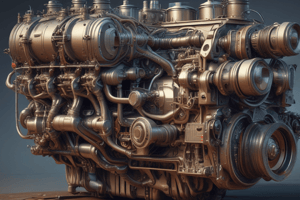Podcast
Questions and Answers
What type of crude oil is primarily composed of saturated hydrocarbons and is generally semi-solid?
What type of crude oil is primarily composed of saturated hydrocarbons and is generally semi-solid?
- Asphalt-based crude
- Naphthene-based crude
- Paraffin-base crude (correct)
- Mixed base crude
What method is used to bring oil to the surface during drilling?
What method is used to bring oil to the surface during drilling?
- Vacuum extraction
- Steam injection
- Hydraulic fracturing
- Air-lift pumping (correct)
Which type of crude oil contains both paraffins and naphthenes but is rich in waxes?
Which type of crude oil contains both paraffins and naphthenes but is rich in waxes?
- Cyclic crude
- Paraffin-base crude
- Asphalt-based crude
- Mixed base crude (correct)
Approximately what percentage of crude oil produced currently falls under the mixed base category?
Approximately what percentage of crude oil produced currently falls under the mixed base category?
What role does hydrostatic pressure play in the extraction of oil?
What role does hydrostatic pressure play in the extraction of oil?
What does the gross calorific value (GCV) represent?
What does the gross calorific value (GCV) represent?
How is the net calorific value (NCV) defined in relation to GCV?
How is the net calorific value (NCV) defined in relation to GCV?
Which element is NOT considered in Dulong's formula for calculating calorific value?
Which element is NOT considered in Dulong's formula for calculating calorific value?
What is the latent heat of steam used in LCV calculations?
What is the latent heat of steam used in LCV calculations?
What does the presence of 90% carbon imply about the type of coal?
What does the presence of 90% carbon imply about the type of coal?
Which hydrocarbons are predominantly found in petroleum?
Which hydrocarbons are predominantly found in petroleum?
What is the primary source of crude oil?
What is the primary source of crude oil?
Which of the following metals is NOT commonly found in petroleum?
Which of the following metals is NOT commonly found in petroleum?
What is the primary characteristic of a substance classified as fuel?
What is the primary characteristic of a substance classified as fuel?
Which of the following is NOT a method for classifying fuels?
Which of the following is NOT a method for classifying fuels?
What is the transformation sequence from vegetable matter to anthracite coal?
What is the transformation sequence from vegetable matter to anthracite coal?
Which element is typically NOT part of the composition of coal?
Which element is typically NOT part of the composition of coal?
What is the average calorific value range of wood?
What is the average calorific value range of wood?
Which analysis method determines the percentages of volatile matter, fixed carbon, ash, and moisture in coal?
Which analysis method determines the percentages of volatile matter, fixed carbon, ash, and moisture in coal?
What does combustion primarily convert in fuels?
What does combustion primarily convert in fuels?
Which type of fuel has extensive application in engineering and is derived from prehistoric plants?
Which type of fuel has extensive application in engineering and is derived from prehistoric plants?
Flashcards are hidden until you start studying
Study Notes
Fuels
- Fuels react with oxygen to produce heat
- Fuels contain combustible elements such as carbon, hydrogen, sulfur, etc.
- Fuels are classified according to their physical state (solid, liquid, or gas) and how they are obtained (naturally or manufactured).
Solid Fuels
- Wood is derived from tree trunks and branches
- Wood typically contains 15% moisture
- Its application as an engineering fuel is limited due to its low calorific value (4000-6400 Btu/lb)
- Coal is a highly carbonaceous solid fuel formed from prehistoric plants
- Coal contains carbon, hydrogen, oxygen, and non-combustible inorganic matter (ash)
- Coal Metamorphism: Stages of coal formation: peat, lignite, bituminous coal, anthracite
- With progressive transformation, carbon content increases, while moisture, volatile matter, and oxygen content decrease
- Coal's calorific value and hardness increase with each stage.
Analysis of Coals
- Proximate Analysis: Determines the percentages of volatile matter, fixed carbon, ash, and moisture in air-dried coal.
- Ultimate Analysis: Determines the percentages of carbon, hydrogen, oxygen, nitrogen, and sulfur in coal
Coke
- Coke is formed by carbonizing bituminous coal.
Calorific Value
- Gross Calorific Value (GCV) : Heat liberated during combustion of a unit mass of fuel, assuming all water produced is in liquid form
- Net Calorific Value (NCV): Heat liberated during combustion of a unit mass of fuel, assuming all water produced is in vapor form
- NCV is always less than GCV by the amount of heat needed to vaporize water.
- Dulong's Formula: Calculates calorific value from the chemical composition of fuel:
- GCV = [8080C + 34500(H - O/8) + 2240S] kcal/kg
- NCV = [GCV - 9(H)*587] kcal/kg
- Problem 1:
- Coal composition: C=90%, O=3%, S=0.5%, N=0.5%, ash=2.5%
- NCV = 8490.5 kcal/kg
- Calculate H and GCV
Liquid Fuels
- Petroleum (crude oil) is a mixture of hydrocarbons, mainly paraffins, naphthenes, and aromatics
- Petroleum contains trace amounts of metals like silicon, iron, aluminum, calcium, magnesium, and nickel.
- It is formed from organic matter (marine sediments) transformed by anaerobic bacteria under pressure and heat over millions of years.
Classification of Petroleum
- Paraffin-base crude: Composed of saturated hydrocarbons up to C35H72, including waxes.
- Asphalt-base crude: Mainly contains naphthenes and cycloparaffins, with lower proportions of paraffins and aromatics.
- Mixed base crude: Contains both paraffin and asphalt-base compounds, but is rich in waxes.
- Approximately 90% of current crude oil production falls into this category.
Petroleum Extraction
- Drilling: Wells drilled to reach oil reservoirs
- Hydrostatic Pressure: Oil is brought to the surface using the pressure of natural gas or by compressed air forced through a coaxial pipe system.
- Crude oil is sent to refineries for processing and refinement.
Studying That Suits You
Use AI to generate personalized quizzes and flashcards to suit your learning preferences.





